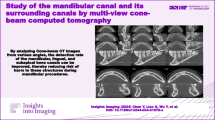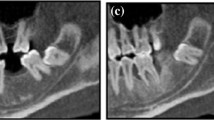Abstract
The location and configuration of the mandibular canal are important in surgical procedures involving the mandible. Previously, we reported that bifid mandibular canals could be classified into four types: retromolar, dental, forward, and bucco-lingual canals, using cone-beam computed tomography (CBCT). Herein we report three Japanese patients with a bony canal in the mandibular ramus, which was independent of the mandibular canal, using CBCT images. A CBCT unit with a flat panel detector and exposure volume of 102 mm in diameter and 102 mm in height was used. Two-dimensional (2D) and three-dimensional (3D) images in the mandibular ramus region were reconstructed using 3D visualization and measurement software packages. Three bony canals in two patients were considered to correspond to a temporal crest canal, which was raised from the mandibular notch, and reached the antero-inferior region of the coronoid process. One bony canal in one patient, ran bucco-lingually in the mandibular ramus. It is important for variations in the mandibular and bony canals to be carefully observed, by use of CBCT images, in surgical procedures involving the mandible.




Similar content being viewed by others

References
Naitoh M, Hiraiwa Y, Aimiya H, Gotoh M, Ariji Y, Izumi M, et al. Bifid mandibular canal in Japanese. Implant Dent. 2007;16:24–32.
Carter RB, Keen EN. The intramandibular course of the inferior alveolar nerve. J Anat. 1971;108:433–40.
Kodera H, Hashimoto I. A case of mandibular retromolar canal: elements of nerves and arteries in this canal. Kaibougaku Zasshi. 1995;70:23–30. (article in Japanese).
Ossenberg NS. Temporal crest canal: case report and statistics on a rare mandibular variant. Oral Surg Oral Med Oral Pathol. 1986;62:10–2.
Ossenberg NS. Retromolar foramen of the human mandible. Am J Phys Anthropol. 1987;73:119–28.
Naitoh M, Hiraiwa Y, Aimiya H, Ariji E. Observation of bifid mandibular canal using cone-beam computerized tomography. Int J Oral Maxillofac Implants. 2009;24:155–9.
Naitoh M, Hiraiwa Y, Aimiya H, Gotoh K, Ariji E. Accessory mental foramen assessment using cone-beam computed tomography. Oral Surg Oral Med Oral Pathol Oral Radiol Endod. 2009;107:289–94.
Naitoh M, Nakahara K, Hiraiwa Y, Aimiya H, Gotoh K, Ariji E. Observation of buccal foramen in mandibular body using cone-beam computed tomography. Okajimas Folia Anat Jpn. 2009;86:25–9.
Kawai T, Asami R, Sato I, Yoshida S, Yosue T. Classification of the lingual foramina and their bony canals in the median region of the mandible: cone beam computed tomography observations of dry Japanese mandibles. Oral Radiol. 2007;23:42–8.
Naitoh M, Nakahara K, Hiraiwa Y, Gotoh K, Ariji E. Comparison between cone-beam and multislice computed tomography depicting mandibular neurovascular canal structures. Oral Surg Oral Med Oral Pathol Oral Radiol Endod. 2009 (in press).
Rosset A, Spadola L, Ratib O. OsiriX: an open-source software for navigating in multidimensional DICOM images. J Digit Imaging. 2004;17:205–16.
Mraiwa N, Jacobs R, van Steenbergen D, Quirynen M. Clinical assessment and surgical implications of anatomic challenges in the anterior mandible. Clin Implant Dent Relate Res. 2003;5:219–25.
Acknowledgments
We thank Dr A. Katsumata from the Asahi University School of Dentistry for his advice regarding analysis of CBCT images.
Author information
Authors and Affiliations
Corresponding author
Rights and permissions
About this article
Cite this article
Naitoh, M., Nakahara, K., Suenaga, Y. et al. Variations of the bony canal in the mandibular ramus using cone-beam computed tomography. Oral Radiol 26, 36–40 (2010). https://doi.org/10.1007/s11282-009-0030-0
Received:
Accepted:
Published:
Issue Date:
DOI: https://doi.org/10.1007/s11282-009-0030-0



